WM2020 Conference, March 8–12, 2020, Phoenix, Arizona, USA
1
Middlesex South FUSRAP Site: Collaboration Towards Beneficial Reuse – 20338
Darina Castillo*, Jill Bennett**, and Carl Young**
*US Department of Energy Office of Legacy Management
**Navarro Research and Engineering, Inc.
ABSTRACT
The US Department of Energy (DOE) Office of Legacy Management (LM) manages DOE’s post-closure
responsibilities and ensures the future protection of human health and the environment with respect to sites that
have no continuing DOE mission after undergoing remediation. LM’s beneficial reuse program promotes the
LM strategic goal to sustainably manage and optimize use of public lands. The beneficial reuse program aims
to repurpose former contaminated sites to restore the environment, protect the public health, revitalize
communities, and spur economic growth. Benefits from the reuse of a site may increase the local tax base,
facilitate job growth, utilize existing infrastructure, and enhance or protect natural resources. Beneficial reuse
also promotes protectiveness by ensuring activities are compatible with long-term maintenance and protection
of public health and the environment, as well as by retaining good stewardship of natural resources. LM
actively participates in promoting the economic development vision of the surrounding communities by
collaborating with local communities to promote regional or municipal initiatives.
The Borough of Middlesex, New Jersey, has prepared the Lincoln Boulevard Redevelopment Plan, which will
reinvent a once-viable downtown and enhance the quality of life for the community. The Middlesex South,
New Jersey, Formerly Utilized Sites Remedial Action Program (FUSRAP) site lies within the boundaries of
this redevelopment area. In support of this development plan, the Borough is interested in acquiring the site for
its Department of Public Works and to increase street access in the future commercial district to be built near
adjacent properties. The opportunity to put the FUSRAP site into productive use aligns with LM’s mission and
strategic goals.
In support of beneficial reuse activities, DOE can dispose of excess real property using several mechanisms.
The two disposal options applicable to the Middlesex south site include (1) utilizing the US General Services
Administration (GSA) or (2) using the Title 10 Code of Federal Regulations Section 770, “Transfer of Real
Property at Defense Nuclear Facilities for Economic Development” (known as a “770 transfer”) process.
Using the 770 transfer requires economic development as the primary driver, and a specific redevelopment
proposal must be submitted. If there is no interest in specific economic development, the GSA option becomes
the default mechanism for disposal of the property. In the case of the Middlesex south site, the 770 transfer
process is being utilized and the Borough has submitted its economic development proposal to LM.
Although LM is encouraged by the opportunity to put the site into productive use, the Middlesex south site is
currently on the US Environmental Protection Agency (EPA) National Priorities List and remediation is being
performed by the US Army Corp of Engineers (USACE) under the Comprehensive Environmental Response,
Compensation, and Liability Act (CERCLA). Consequently, any property transfer must meet the requirements
under CERCLA Section 120(h), “Property Transferred by Federal Agencies.” As the groundwater remedy will
not be in place for several years, approval would be required from the US EPA administrator and the governor
of the state of New Jersey to perform an early transfer of the site (before all response actions have been
completed). The time frame for these approvals to occur under the normal process conflicts with the proposed
redevelopment schedule; therefore, various options for expedited sale, transfer, or lease of portions of the site
to the Borough were evaluated. The subsequent decision on a mutually beneficial path forward was the result
of a collaborative effort between LM, USACE, the Borough and its redevelopment team, EPA, and the New
Jersey Department of Environmental Protection.
WM2020 Conference, March 8–12, 2020, Phoenix, Arizona, USA
2
INTRODUCTION
Beneficial reuse supports the US Department of Energy (DOE) Office of Legacy Management (LM) mission
to fulfill DOE’s post-closure responsibilities and ensure the future protection of human health and the
environment. LM achieves this mission in part through its Beneficial Reuse Program, which supports the
strategic goals of sustainable management and optimization of the use of land and assets and the
protection of public health and the environment. Beneficial reuse also promotes stewardship of natural
resources and allows DOE to actively participate in achieving the economic development vision of the
surrounding communities.
When a site is no longer needed for its current or future mission, LM will make the site available for
beneficial reuse by others. LM encourages the beneficial reuse of its sites through a variety of reuse
opportunities, including agricultural, community reuse, conservation (habitat protection), cultural
resources, commercial and industrial, disposal, and renewable energy.
As of September 2017, 45 properties were available for reuse, with more than 95% of available LM sites
in reuse (see the LM beneficial reuse website).Two examples of successful property transfers for
beneficial reuse are the Wayne and New Brunswick, New Jersey, sites. The 2.6-hectare (6.5-acre) Wayne
site had been used in the 1940s for processing monazite sand to extract thorium and rare-earth metals.
Later, the site was also used as an interim storage pile. In 1982, the US Environmental Protection Agency
(EPA) added the site to the National Priorities List (NPL). The property was remediated and, in 2006,
transferred from DOE to Wayne Township for park and recreational use under the National Park
Service’s Land to Parks Program. The township has constructed a public playground and dog park on the
site. EPA deleted the site from the NPL in 2012. The 2.2-hectare former New Brunswick Laboratory site
was used for nuclear reactor and weapons programs from 1948 to 1977. By 2001, the property was
remediated by DOE and, in 2009, was sold to a private owner. This property is currently undergoing
redevelopment as a 6,689 square meter (72,000 square foot) waste transfer station.
DOE has other reuse partnership programs, such as a long-standing partnership known as
Reindustrialization, with the Community Reuse Organization of East Tennessee. The partnership
accelerated the cleanup of a former gaseous diffusion plant in Oak Ridge and created a 486-hectare
(1200-acre) mixed-use private sector industrial/business park. The area is a prime example of
redeveloping a former DOE facility. Many of the property transfers were completed under Title 10 Code
of Federal Regulations Section 770 (10 CFR 770), “Transfer of Real Property at Defense Nuclear
Facilities for Economic Development,” known as a “770 transfer.”
The DOE process for property transfers under a 770 transfer is very similar to the Department of Defense
process to document parcels of real estate made available through the Base Realignment and Closure
process. Both processes comply with Section 120(h) of the Comprehensive Environmental Response,
Compensation, and Liability Act (CERCLA) with respect to documenting the environmental suitability of
a property for transfer.
The Middlesex South site, in the Borough of Middlesex, New Jersey, is undergoing remediation by the
US Army Corps of Engineers (USACE) in the Formerly Utilized Sites Remedial Action Program
(FUSRAP). FUSRAP was established in 1974 to identify, investigate, and clean up or control sites that
had become contaminated while performing nuclear work for the Manhattan Project or Atomic Energy
Commission. Under FUSRAP, when USACE completes remediation, the long-term surveillance and
maintenance responsibilities revert to the DOE Office of Legacy Management. The Middlesex south site
is one of four FUSRAP sites that are owned by the United States of America; the other sites are the
Maywood (New Jersey), Colonie (New York), and Niagara Falls Storage Site (New York) sites.
WM2020 Conference, March 8–12, 2020, Phoenix, Arizona, USA
3
The site lies within the boundaries of the Borough’s proposed Lincoln Boulevard Redevelopment Plan,
which will reinvent a once-viable downtown and enhance the quality of life for the community. The
Borough is interested in acquiring the government-owned property for its Department of Public Works
and to increase street access in the commercial district. The opportunity to put the FUSRAP site into
beneficial use aligns with DOE’s mission and strategic goals. This paper provides an overview of the
site, the proposed redevelopment, and the processes and stakeholders involved in seeing this project come
to fruition.
Middlesex South Site History
The site was originally occupied by an asphalt paint manufacturing company as early as 1910. During
1943, the government leased and eventually took possession of the site to establish the Middlesex
Sampling Plant (MSP). The MSP supported both the development of atomic bombs during World War II
and the Cold War nuclear weapons complex. The MSP was initially utilized to mechanically process,
assay, and package uranium ores to support the Manhattan Engineer District and was operated until
February 18, 1955. At this time the duties and responsibilities were completely transferred to the
Sampling Plant at the Feed Materials Production Center at Fernald, Ohio. Toward the end of MSP
operations (1952–1954) and to a much lesser extent, the facility was also utilized to mechanically process,
assay, and package beryllium ores. After MSP operations ended, the property was used for storage of
containers holding materials containing uranium and thorium (1955–1968). In 1968, the US General
Services Administration (GSA) transferred the property to the US Department of the Navy. The site
served as a US Marine Corps reserve training center from 1969 to 1979 before it was placed in the
custody of DOE in 1980 for environmental remediation.
In 1948, contaminated materials had been trucked from the MSP and disposed of at the Middlesex
Municipal Landfill (MML), approximately 0.8 kilometer (0.5 mile) from the MSP. These operations
resulted in off-site migration of radiological contamination onto a number of vicinity properties (VPs).
The VPs were remediated by DOE in the 1980s, along with the contaminated materials disposed of at the
MML. All materials were brought back to the MSP site and stored in specially constructed storage piles,
as shown in Figure 1.
USACE took responsibility for remedial actions in 1998 under FUSRAP. In 1999, EPA placed the site on
the NPL for hazardous waste sites, and remediation is being performed in accordance with CERCLA.
USACE removed and disposed of the waste storage piles and then excavated and disposed of over 78,925
metric tons (87,000 tons) of radiologically and chemically impacted soil. USACE remediated the soil to
unrestricted use standards and completed the work in 2008. Figure 2 shows current site conditions.
There is a groundwater plume in the shallow aquifer emanating from the northern portion of the site
consisting of dissolved chlorinated solvents. In 2017, USACE completed a feasibility study for the
groundwater operable unit and is currently developing the proposed plan for groundwater remediation.
Several years will be needed before the site is transferred to LM, and it is anticipated that LM will then
conduct a long-term groundwater monitoring program.
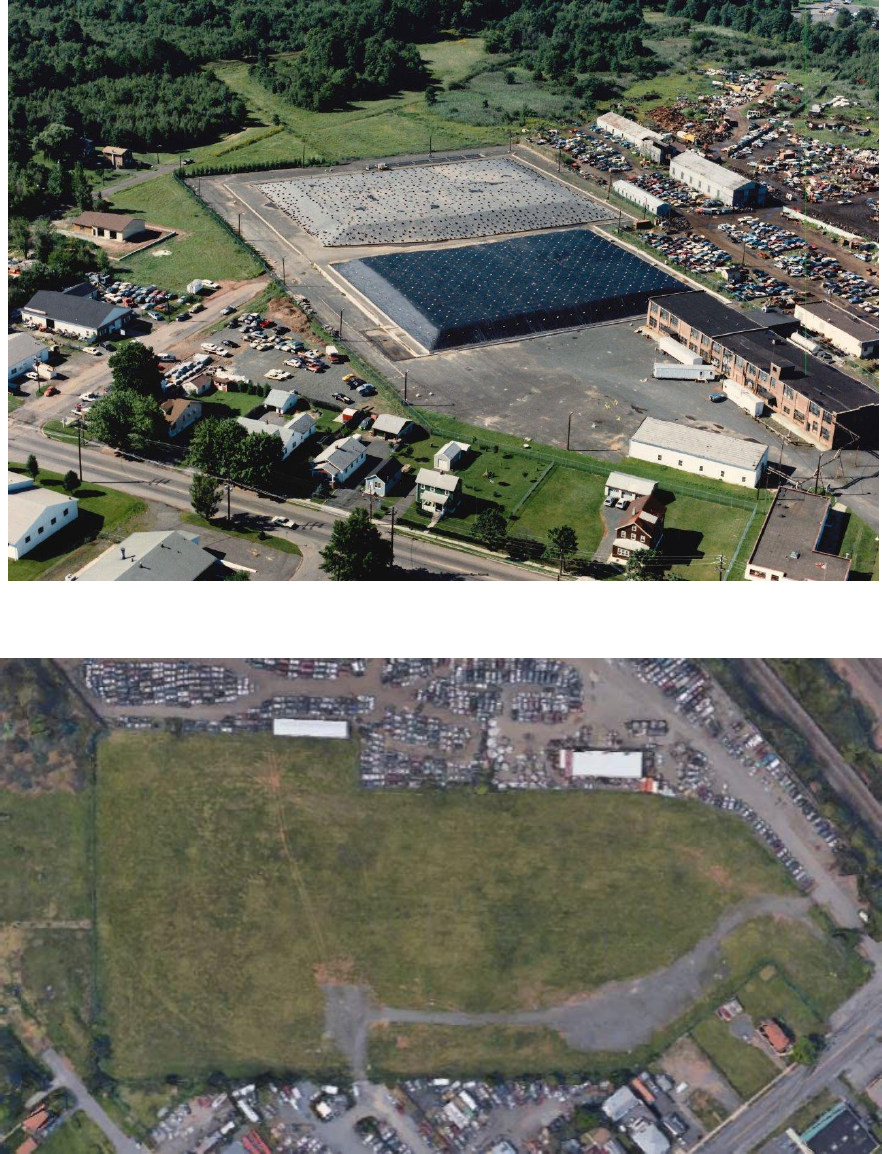
WM2020 Conference, March 8–12, 2020, Phoenix, Arizona, USA
4
Fig. 1. Middlesex Sampling Plant with Interim Storage Piles, September 1986
Fig. 2. Middlesex South Site Conditions 2019 with Interim Storage Piles Removed
WM2020 Conference, March 8–12, 2020, Phoenix, Arizona, USA
5
Borough Planning for Redevelopment
The Borough adopted a Redevelopment Plan in 2007, the result of years of collaborative planning
between the Middlesex Borough staff, council, planning board, and community. The plan established
goals for the future of the area along Lincoln Boulevard and Mountain Avenue. The Middlesex south site
and the adjacent auto salvage yard are included in the redevelopment area’s designated Transitional Zone.
The Borough’s redevelopment goals include:
•
Eliminating the underutilization of the designated Redevelopment Area and eliminating
blighting influences.
•
Allowing for more efficient use of land and expanding the Borough’s tax base by encouraging
high-quality development.
•
Expanding the level of business activity in the Lincoln Boulevard Rehabilitation Area, thereby
increasing the potential for economic activity and job creation.
Consistent with these goals, transfer of the Middlesex south site will allow the Borough to use a portion
of the property for critical municipal functions and create the opportunity for new development on the
current Department of Public Works (DPW) property. The extension of a public road on the property will
provide adequate access for the redevelopment of the adjacent auto salvage yard (Figure 3). These
proposed redevelopments will help to increase the quality of life and reinvent a once-viable downtown in
the Borough.
As part of the overall planning, an initial meeting was held in November 2018 to discuss the Borough’s
development concept. Key agencies were represented—DOE, USACE, EPA, and New Jersey Department
of Environmental Protection (NJDEP)—as well as the Borough and its developers. This meeting outlined
the goals of redevelopment, established a collaborative relationship between all parties, and discussed
initial options for a path forward. The 770 transfer process was presented, and group discussions were
held regarding potential subdivision of the site, related CERCLA documentation and regulatory approval
requirements, and the potential use of a license or easement option to provide early access to the southern
portion for construction of the public road extension.
After these discussions, DOE performed more detailed evaluations on the potential path forward while
addressing the goals of the Borough. These evaluations included determining the best disposition method
and appropriate environmental condition documentation.
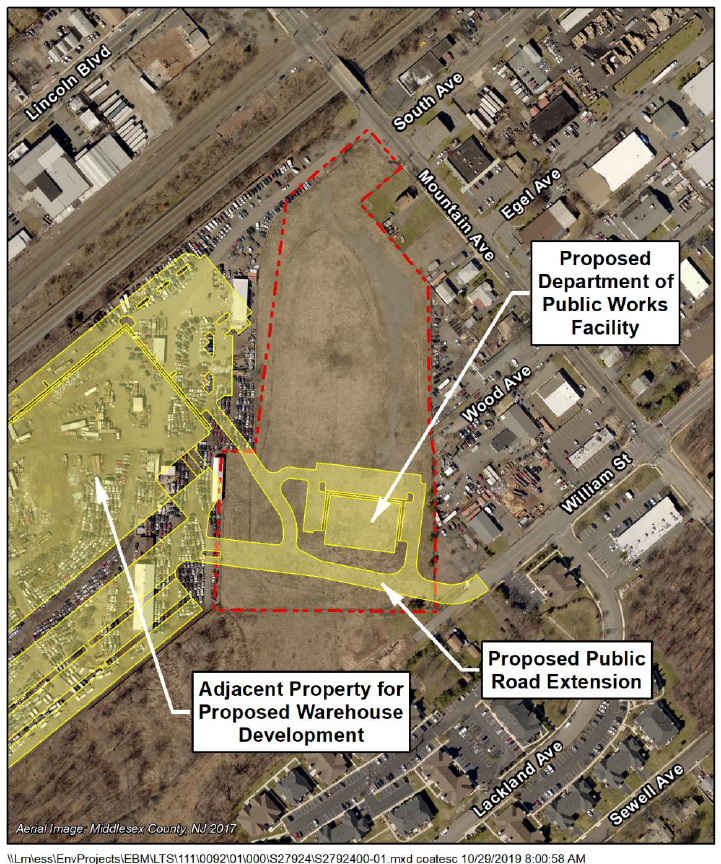
WM2020 Conference, March 8–12, 2020, Phoenix, Arizona, USA
6
Fig. 3. Location of Department of Public Works Facility, Public Road Extension,
and Adjacent Redevelopment Area
PROPERTY TRANSFER OPTIONS EVALUATION
Disposal is defined as the “permanent transfer of DOE control and custody of real property assets to a
third party who thereby acquires rights to control, use, or relinquish the property” (DOE Order 430.1C,
Real Property Asset Management) [1]. Disposal is LM’s preferred beneficial reuse option where possible
because it reduces DOE’s overall land holdings, the federal footprint, and associated maintenance costs.
Additionally, the disposed of properties can be viable economic development tools to increase local jobs,
tax base, and convert typically vacant properties into useful community assets. DOE-owned properties
selected for disposal are evaluated to determine the best method for disposal using either the GSA
disposal process or, in some circumstances, a direct transfer of excess facilities by DOE. The selection of
a disposal process for a DOE-owned property is dependent on a few factors such as the historical use of
the site, the redevelopment proposal, interest from local governmental organizations such as community
reuse organizations, and economic development potential.
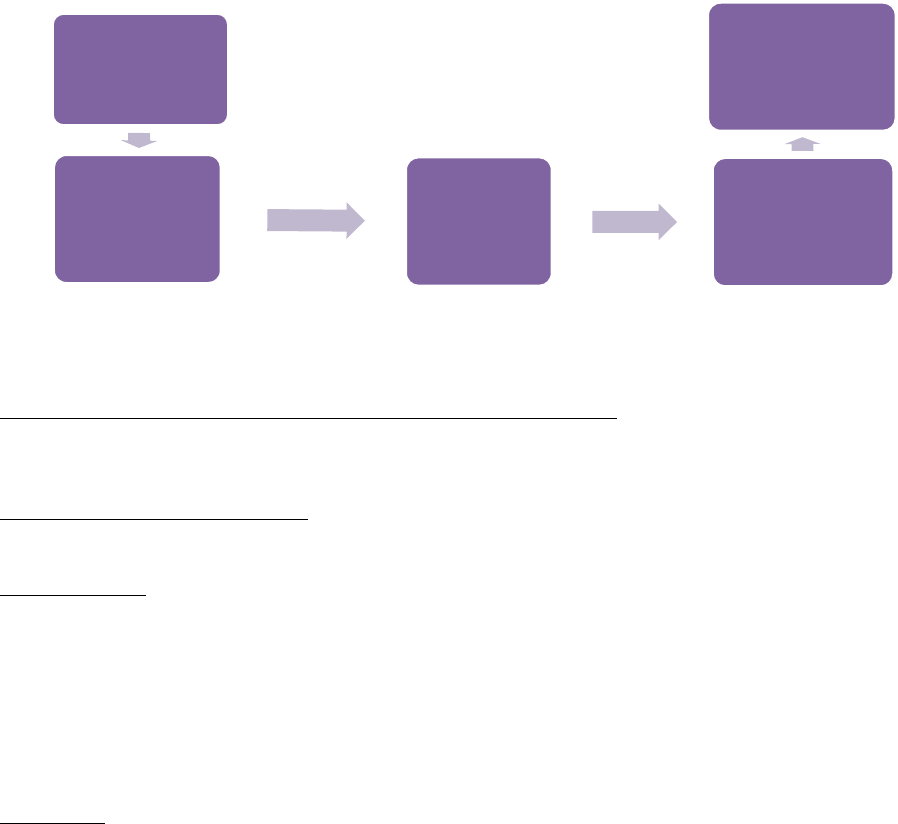
WM2020 Conference, March 8–12, 2020, Phoenix, Arizona, USA
7
GSA Disposal Process
All real property deemed as excess must first be screened through DOE to confirm that the property is no
longer necessary to carry out its program responsibilities. The property is then turned over to the GSA
Office of Real Property Utilization and Disposal. DOE submits a Report of Excess to GSA, along with
other supporting materials to effectuate the transfer. GSA is required to first offer excess property to other
federal agencies that may have a programmatic need for it. If there is no need for the property within the
federal government, the property is determined “surplus” and may be conveyed under GSA-approved
methods of transferring real property. Transfer mechanisms include homeless conveyance, public benefit,
negotiated sale, and public sale, as shown in Figure 4.
Fig. 4. Transfer Mechanisms Under the GSA Process
Homeless Conveyance (McKinney-Vento Homeless Assistance Act): If a property is suitable to assist the
homeless, GSA must first offer the property as a Homeless Conveyance before any other public uses can
be considered.
Public Benefit Conveyance (PBC): As a PBC, the property can be substantially discounted in price (up to
100% reduction in fair market value) if it is used for a qualified public use.
Negotiated Sale: If a qualified public benefit conveyance cannot be identified for the property, GSA can
negotiate a sale at appraised fair market value with a state or local government if the property will be used
for a public purpose. This transaction offers state or local governments the right of first refusal on a
property before it is offered to the general public. With these types of transfers, the state or local
government will either develop the property or make substantial improvements with the intention to resell
or lease the land to support and further economic development. To support this type of sale, GSA
evaluates whether the benefits to the community are greater than those proceeds recognized under a
public sale of the property
Public Sale: If state and local governments or other eligible nonprofits do not wish or do not qualify to
acquire the property, GSA’s Office of Real Property Utilization and Disposal can dispose of surplus
property via a competitive sale to the public, generally through a sealed bid or auction (oral and online
AGENCY REPORTS
PROPERTY EXCESS TO
GSA FOR DISPOSITION
DETERMINED
SURPLUS IF NOT
TRANFERRED TO
ANOTHER FEDERAL
AGENCY
PROPERTY
AVAILABLE FOR
CERTAIN PUBLIC
USES UP TO 100%
DISCOUNT
TO ELIGIBLE PUBLIC
BODIES FOR OTHER
PUBLIC USES FAIR
MARKET VALUE
REQUIRED
OFFERED TO PUBLIC
AND PRIVATE PARTIES
VIA AUCTION OR
SEALED BID FAIR
MARKET VALUE
AIRPORT
CORRECTIONAL
EDUCATION
HISTORIC
HOMELESS
LAW ENFORCEMENT/
EMERGENCY
MANAGEMENT
PARK & RECREATION
PUBLIC HEALTH
SELF HELP HOUSING
WILDLIFE CONSERVATION
PORT
DISPOSAL PROCESS
Excess
Federal Transfer
Discount
Negotiated Sale
Public Sale

WM2020 Conference, March 8–12, 2020, Phoenix, Arizona, USA
8
located at https://disposal.gsa.gov/).The appraised fair market value is used as a guide to sell federal real
estate.
770 Transfers
DOE has authority to transfer, sell, or lease real property for economic development purposes under 10
CFR 770, “Transfer of Real Property at Defense Nuclear Facilities for Economic Development” [2]. Only
DOE-owned real property at a “defense nuclear facility” qualifies for this type of transfer, commonly
called 770 transfers. DOE annually makes available to community reuse organizations and other persons
a list of available real estate identified as appropriate for economic development. Any person or entity
may also request that a specific piece of real estate be made available for economic development
purposes. With respect to these types of requests, DOE requires a proposal from the prospective person or
entity to be submitted for the transfer of real property. The proposal must include the following:
• A description of the real property proposed to be transferred
• The intended use and duration of use of the real property
• A description of the economic development that would be furthered by the transfer (e.g., jobs to
be created or retained, improvements to be made)
• Information supporting the economic viability of the proposed development
• The consideration offered (i.e., payment or money or other thing of value) and any financial
requirements
Within 90 days of receipt of the proposal, DOE will notify the entity of its decision whether a transfer is
in the best interest of the government (i.e., to sell or lease the real property). If DOE decides that it is in
the best interest of the government, the DOE field office manager (the LM director) will approve the
development of the transfer agreement. DOE has additional steps that it must perform to obtain final
approvals for this type of transfer. Figure 5 illustrates this process. The full process may take up to 24
months to complete.
Fig. 5. 10 CFR 770.6 – Request to Make Property Available Process
Request that DOE make
property available
Review request/early
"proposal" to transfer the
available property and reply,
agreeing to evaluate the
property requested
Perform environmental and
other due diligence reviews on
requested property
Assess utilization and assess
mission need for real property
Obtain regulatory approval for
the environmental due diligence
work
Provide information on the
condition of the property, etc.
Review early proposal, obtain
additional information and
make preliminary BIG
determination on whether to
continue the "transfer process"
Develop/assemble all pertinent
materials for the draft transfer
agreement
Obtain HQ review and approval
of the BIG determination and
the proposed transfer
Congressional committee
notification
Complete the transfer
agreement
Execute the quitclaim deed
10 CFR 770.6 process of making a request to make property available for economic development purposes
18–24 months
Request/Review/ Evaluation/Proposal/Transfer Phases
Notification/Transfer/Execution Phases

WM2020 Conference, March 8–12, 2020, Phoenix, Arizona, USA
9
770 PROCESS SELECTION FOR MIDDLESEX PROPERTY
The 770 process was selected for the Middlesex site because it met the criteria of having been excess to
the DOE mission, the property would be used as a benefit to the community and transferred to the
Borough of Middlesex, the property would support a local economic development, and the historical use
of the property supported the departments weapons development mission. Table 1 shows a review of the
Borough proposal against the primary GSA and 10 CFR 770 requirements.
TABLE 1. Borough Proposal Review Against the GSA and 10 CFR 770 Requirements
GSA REQUIREMENTS
BOROUGH
PROPOSAL
COMPARED TO
GSA
DOE AUTHORITY
(10 CFR 770 AND
ATOMIC ENERGY
COMMISSION 161G)
BOROUGH
PROPOSAL
COMPARED
TO 10 CFR
770
May utilize a PBC
No
Needs proposal from
government organization
and third party
Yes
May result in private party sale
No
Designed for economic
development
Yes
--
--
Must notify Congress
--
ELEMENTS COMMON TO GSA AND 10 CFR 770
BOROUGH PROPOSAL
Needs SF118 Package
Yes
Fair market value (may be discounted with approval)
Yes
Needs environmental conditions review
Yes
ENVIRONMENTAL CONDITION REVIEW OF THE SITE
Once a disposal process was selected, both the Borough and DOE could proceed to develop the
documents necessary to initiate the disposal. Key components of the disposal package include an
environmental condition review performed to determine the appropriate steps to address regulatory and
departmental requirements for the disposition of the site. CERCLA, National Environmental Policy Ac ,
and DOE Orders were identified as needing to be addressed in the disposition process. Since the
Middlesex site is an NPL site with the soils remedy in place and groundwater is only impacting a portion
of the site, it was determined that redevelopment was possible with the appropriate documentation of the
environmental condition of the site.
CERCLA Requirements, Section 120(h) Property Transferred by Federal Agencies
Section 120(h) imposes several requirements on all transfers of federal real property “owned by the
United States” to nonfederal entities [3]. The federal government, on deeds related to real property
transactions, is required to provide a covenant warranting that:
• All remedial action necessary to protect human health and the environment with respect to any
WM2020 Conference, March 8–12, 2020, Phoenix, Arizona, USA
10
such substance remaining on the property has been taken before the date of such transfer.
• The United States will return and perform any additional response action that may be required in
the future.
• A perpetual right of access necessary to do such additional response actions is retained.
In addition, CERCLA Section 120(h) requires that property disposals include information on site-related
hazardous substances; historic, archeological, and cultural resources; National Environmental Policy Act
compliance; endangered species and biological resources; floodplains, wetlands, and coastal zone
management; underground storage tanks; polychlorinated biphenyls, lead-based paint and asbestos; radon
gas; and pesticides. To meet this requirement, DOE completes GSA’s “Hazardous Substance Activity
Certification,” Standard Form 118 in the GSA’s Excess Real Property Checklist.
This information is also needed to comply with the DOE Order 430.1C Real Property Asset Management
provision to include environmental requirements in all real property disposals. In addition, DOE Order
458.1, Radiation Protection of the Public and the Environment requires the establishment of approved
authorized limits and independent verification of the radiological condition of a property before it can be
released from DOE control.
CERCLA Environmental Condition Documentation
Finding of Suitability to Transfer (FOST): A FOST documents that the property is environmentally
suitable for transfer by deed under CERCLA and Department of Defense FOST Guidance. The FOST
process was developed to meet the statutory and regulatory requirements associated with transferring
federal real estate. A FOST must demonstrate that either the property is uncontaminated or that all
necessary remediation has been completed or is in place and operating properly and successfully. These
demonstrations are necessary to support the deed covenant required by CERCLA Section 120(h) that all
remedial action necessary to protect human health and the environment has been taken.
Finding of Suitability for Early Transfer (FOSET): A FOSET documents the suitability of the
property for early transfer by demonstrating environmental suitability and appropriate land use controls.
Approval of a FOSET may be a lengthy process, particularly for an NPL site. Both EPA and the state
governor must concur on the early transfer approval; the transfer cannot occur until the CERCLA
guarantee (covenant) is explicitly deferred by EPA and the state.
BOROUGH OF MIDDLESEX PROPOSAL
The transfer of the DOE-owned property offers significant economic benefits to the local community.
After consultation with DOE, the 770 process was selected as the most appropriate disposition pathway to
address the government’s goal of beneficial reuse and the Borough’s goal of economic redevelopment.
The Borough proposes to use the property as the potential site for a new 1,672 square meter (18,000-
square foot) DPW facility. The current DPW building will be replaced with an affordable senior housing
building, which is estimated to generate an additional $100,000 per year in revenue for the municipality.
The Borough will also utilize the property to support the continued extension of an existing public road.
This road extension will assist in facilitating the multimillion dollar redevelopment of an adjacent
property into a warehouse distribution facility by providing safer ingress and egress for vehicular traffic.
The current ingress/egress point on the northern entry has several safety issues: it is a single access point
less than 30 meters (100 feet) from a railroad bridge, there is a 20% grade change from the bridge to the
road, and there is a cross street that is offset from the current access point. In contrast, the new access that
crosses the southern edge of the property at William Street has a lighted intersection and is improved with

WM2020 Conference, March 8–12, 2020, Phoenix, Arizona, USA
11
turn lanes. This adjacent redevelopment would create over one 150 jobs in the area, promoting economic
growth and resulting in significant revenue benefits.
TRANSFER OPTIONS
A collaborative meeting was held in June 2019 between all team members. The transfer options identified
in the November 2018 meeting were discussed in greater detail. Any transfer mechanism would be based
on the ability to conduct an early transfer, which requires coordination with EPA and NJDEP. NJDEP and
EPA allow the transfer of contaminated property; this requires review and approval from the governor as
well as a review and approval signature of the EPA administrator. The overall time frame to gain these
approvals is uncertain.
FOSET: The FOSET process has been used in past early transfers in conjunction with the CERCLA
120(h) process. CERCLA Section 120(h) requires certain environmental information be provided for any
deed transferring US property to another entity. The actual deed needs to contain the Covenant Deferral
Request. In this case, DOE would be executing the deed and providing a warranty on the groundwater
remediation. Limiting factors for early transfer under the FOSET are that the groundwater remedial
alternative for the Middlesex south site is still being identified and the potential property restrictions are
unknown at this time. An early transfer of the site would require that these restrictions be specified in the
transfer documents.
FOST: The possibility of using the FOST process to accelerate environmental review for the transfer was
evaluated. The FOST would require subdividing the property to remove the clean southern portion from
the northern portion containing the groundwater contamination and transferring the clean parcel to the
Borough. The clean portion of the site would be separated and transferred independently from the portion
that requires additional remediation. The limiting factor for the FOST transfer is that the best interest of
the government is to transfer the entire property. The Borough agreed that it would eventually take the
entire site and the DPW facility would not be constructed until the entire property had transferred over.
They also suggested drafting a Memorandum of Understanding (MOU) to outline DOE’s intent to
transfer the property in phases and the Borough’s intent to receive both parcels over time.
Easement: DOE proposed a temporary easement for granting early access to the southern parcel to begin
road construction, as the overall property transfer would be lengthy. The redevelopment agency preferred
an irrevocable license, as financing was difficult to obtain under a temporary access agreement. DOE then
suggested a long-term easement to transfer the area that will include the road to the borough. DOE would
provide a 20-year easement; any longer would require headquarters approval.
PATH FORWARD
During the June 2019 meeting, the team came to a unanimous agreement to develop a final path forward
for the property transfer, which allowed for the subdivision of the existing property and the preparation of
a FOST for the southern parcel. Several tasks were identified and are currently in various stages of
completion:
• Borough of Middlesex Resolution: The Borough Council unanimously adopted Resolution
#202-2019 in July 2019. The resolution authorized the mayor to sign and submit the 770 transfer
proposal and to sign the MOU on behalf of the Borough.
• Memorandum of Understanding: The MOU was entered into by the Borough and LM in
August 2019 and documents that LM and the Borough will enter into an agreement to transfer
title to the entire property. The Borough will be required to provide government access to the site
for remediation and long-term surveillance and maintenance activities. The MOU is important, as
WM2020 Conference, March 8–12, 2020, Phoenix, Arizona, USA
12
it memorializes the intention of the Borough to acquire the entire Middlesex south site for public
purpose and provides for the granting of the easement for extension of the public road.
• Identification of a final property subdivision line: Figure 6 depicts the final subdivision line.
This allowed for the greatest amount of initial land transfer to the Borough, while preserving the
need for government ownership of the northern parcel due to ongoing groundwater remediation
requirements. The line was determined by (1) an identification of the groundwater divide, (2) an
evaluation of groundwater flow patterns, and (3) identifying the southernmost extent of
groundwater contamination.
• Preparation of FOST: A Memorandum of Agreement (MOA) between LM and USACE was
signed in June 2018 with the purpose of establishing a mutual framework governing
responsibility for USACE support of LM on a nationwide basis. Using the framework of the
MOA, DOE contracted USACE to prepare the FOST for state and federal agency review and
concurrence. The FOST and agency concurrent letters will be supporting documentation for the
entire 770 transfer package. A draft FOST was provided for regulatory agency review in
November 2019.
• Easement: It was agreed that LM will grant the Borough an easement to construct, maintain, and
manage the public road extension. This allows an accelerated schedule for road construction, as
the entire 770 transfer process may take up to 2 years to complete.
• Project financing and road construction: Financing will be obtained by the Borough’s
developer once the FOST and easement are completed. The developer will then construct the
public road extension.
• Compilation of a 770 transfer package to DOE headquarters: Per 10 CFR 770.7(c),
Congressional committee notification, DOE may not transfer real property until 30 days have
elapsed after the date DOE notifies congressional defense committees of the proposed transfer.
This notification occurs through the submittal of the 770 transfer package, which includes the
FOST and agency concurrence letters, a summary of environmental baseline conditions, a
determination that the property meets the requirements on DOE Order 485.1, Radiation
Protection of the Public and the Environment, as well as the quitclaim deeds.
• Sales contract: A draft sales contract between DOE and the Borough was prepared in July 2019.
Important aspects of this sales contract include the notice that the property will be conveyed to
the Borough in separate parcels via separate quitclaim deeds, notice of hazardous substances
under CERCLA Section 120(h), a statement that the property will be closed in accordance with
the Federal Facilities Agreement and CERCLA to an industrial use standard, indemnifications to
both the Borough and DOE, and statements that DOE will retain an easement for ingress and
egress and may grant same to NJDEP or EPA to the extent necessary to conduct ongoing
environmental remediation efforts and monitor or assess those efforts.
• DPW construction: The Borough’s developer will construct the new DPW facility after the sales
contract is completed.
• Preparation of FOSET: Using the framework of the MOA, DOE will contract with USACE
under the MOA to prepare the FOSET. The FOSET will be drafted upon USACE completion of
the Groundwater Proposed Plan.
The coordination and completion of these various tasks required an intensive collaborative effort for all
parties involved, as shown in Figure 7. The leadership shown by the representatives from the various local
and federal agencies involved in this process has played a key role in fostering collaboration, gaining
alignment on the shared goal of accomplishing a smooth and efficient disposition of the Middlesex south
site.
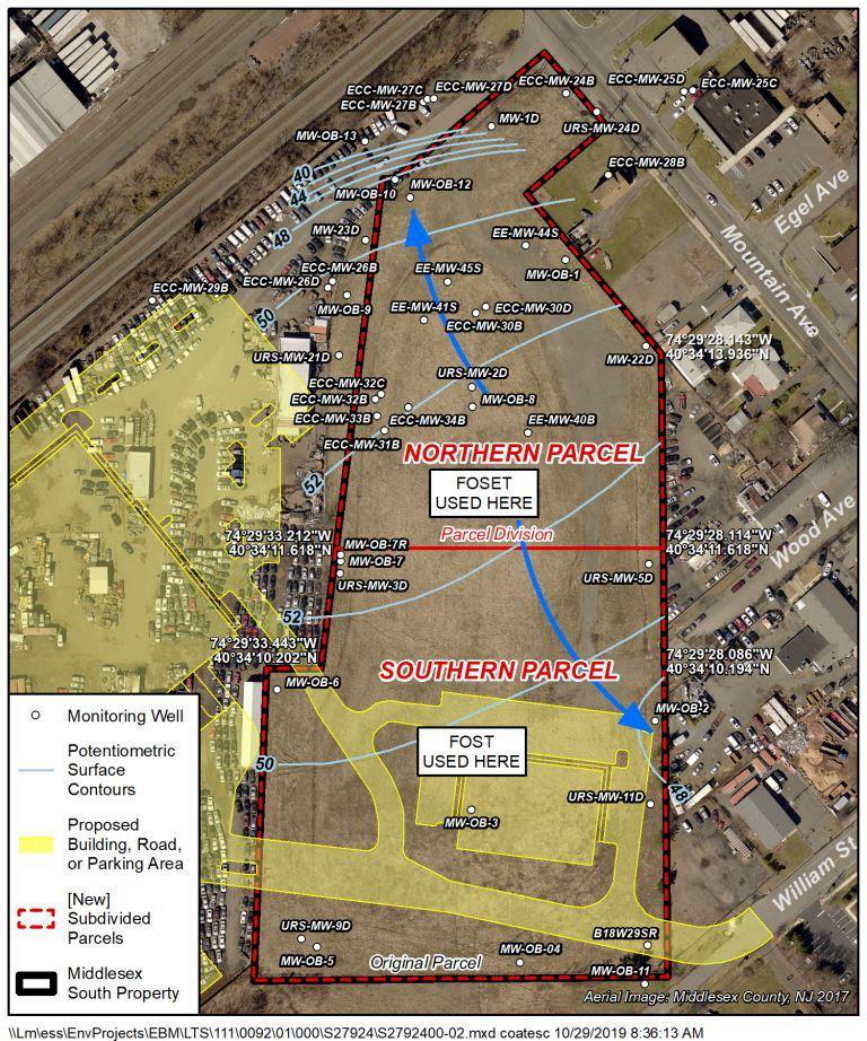
WM2020 Conference, March 8–12, 2020, Phoenix, Arizona, USA
13
Fig. 6. Location of Proposed Subdivision Line and New Property Parcels
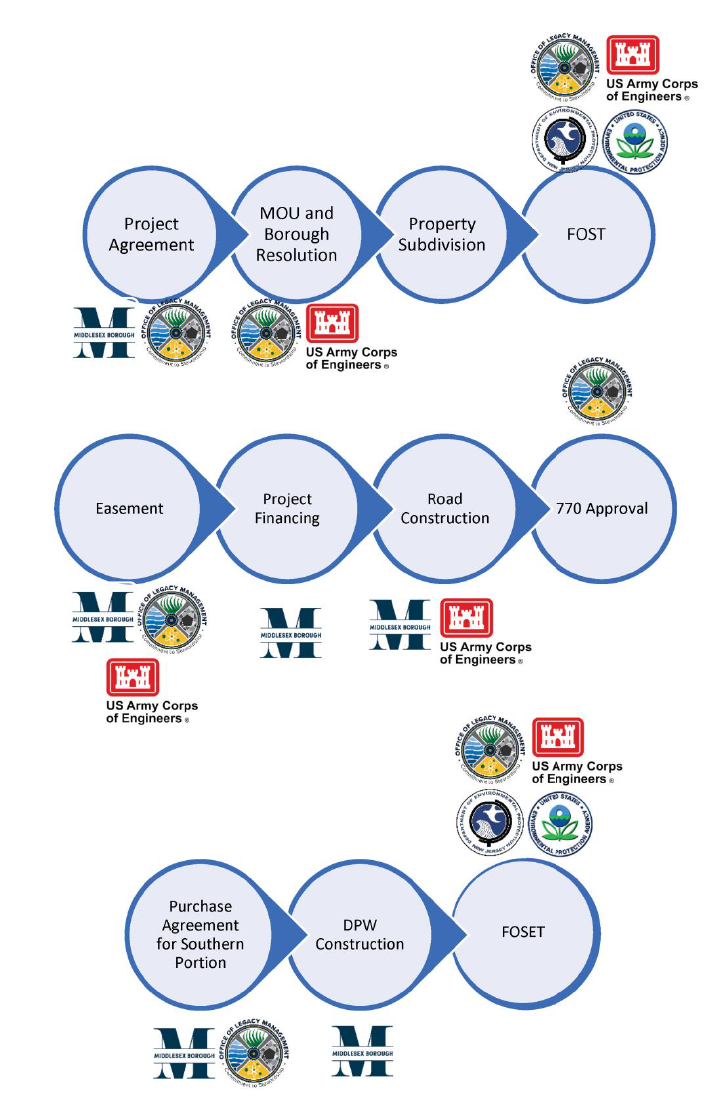
WM2020 Conference, March 8–12, 2020, Phoenix, Arizona, USA
14
Fig. 7. Path Forward Partner Coordination
WM2020 Conference, March 8–12, 2020, Phoenix, Arizona, USA
15
CONCLUSIONS
Numerous challenges were overcome during the decision-making process for property disposition:
• The site is on the NPL and requires future groundwater remediation: obtaining EPA and NJDEP
concurrence with the proposed parcel subdivision and use of the FOST/FOSET process was a
critical factor in allowing the proposed phased transfer to take place.
• Meeting development timelines: government processes can be slow, and the redevelopment
funding windows are short. Key documents were required to secure funding for redevelopment.
• Two agencies were responsible for the input into the final decision: USACE is performing
remediation, conducts all related coordination with regulatory agencies, and maintains the
information required to produce the transfer documents. DOE is the property owner and is using
its authority to perform the transfer.
Numerous benefits will be achieved by this property transfer, including the following: DOE will achieve
goals of reducing government-owned property footprint, disposition of a nonperforming real property
asset, and reducing annual operations and maintenance costs. The Borough will be able to relocate public
works functions and redevelop the current DPW location for enhanced public benefit, generating addition
revenue for the municipality.
REFERENCES
1. DOE Order 430.1C, Real Property Asset Management, US Department of Energy, August 19, 2016.
2. 10 CFR 770, Transfer of Real Property at Defense Nuclear Facilities for Economic Development, Code
of Federal Regulations.
3. 42 USC 9601 et seq., CERCLA Section 120(h), Property Transferred by Federal Agencies, United
States Code.
